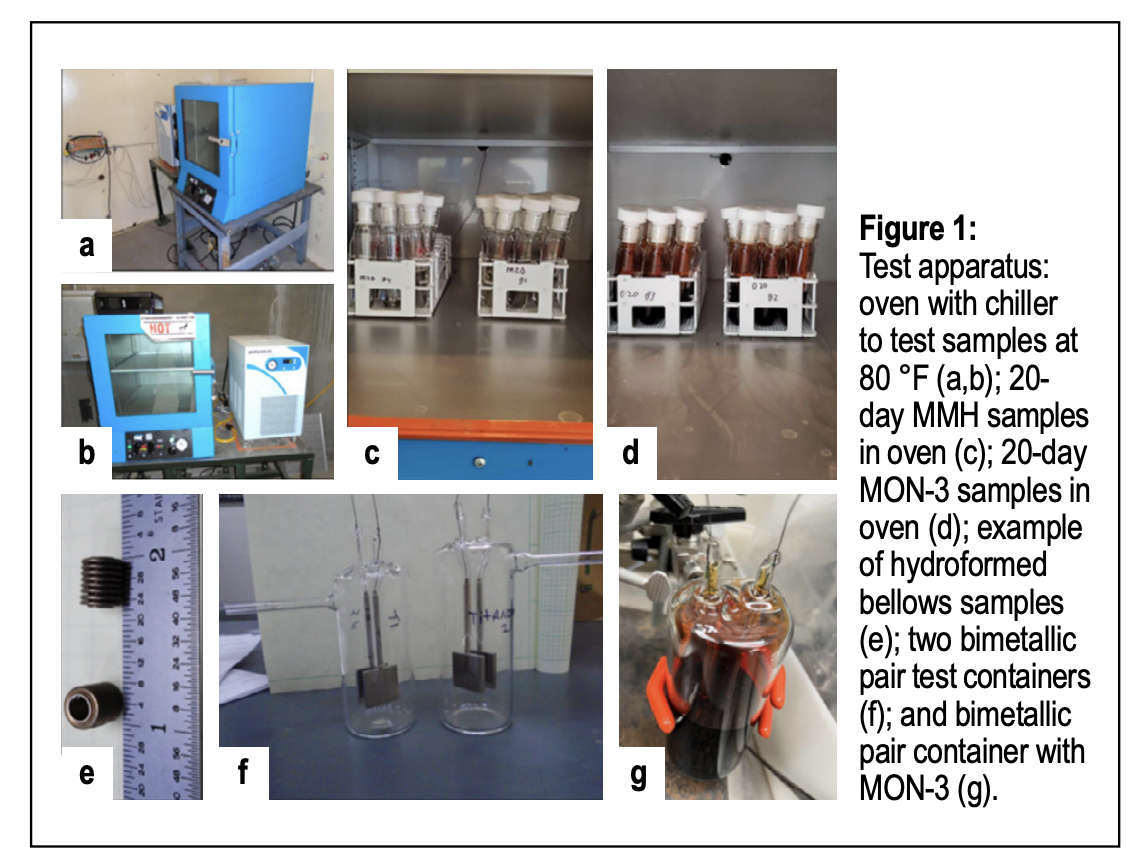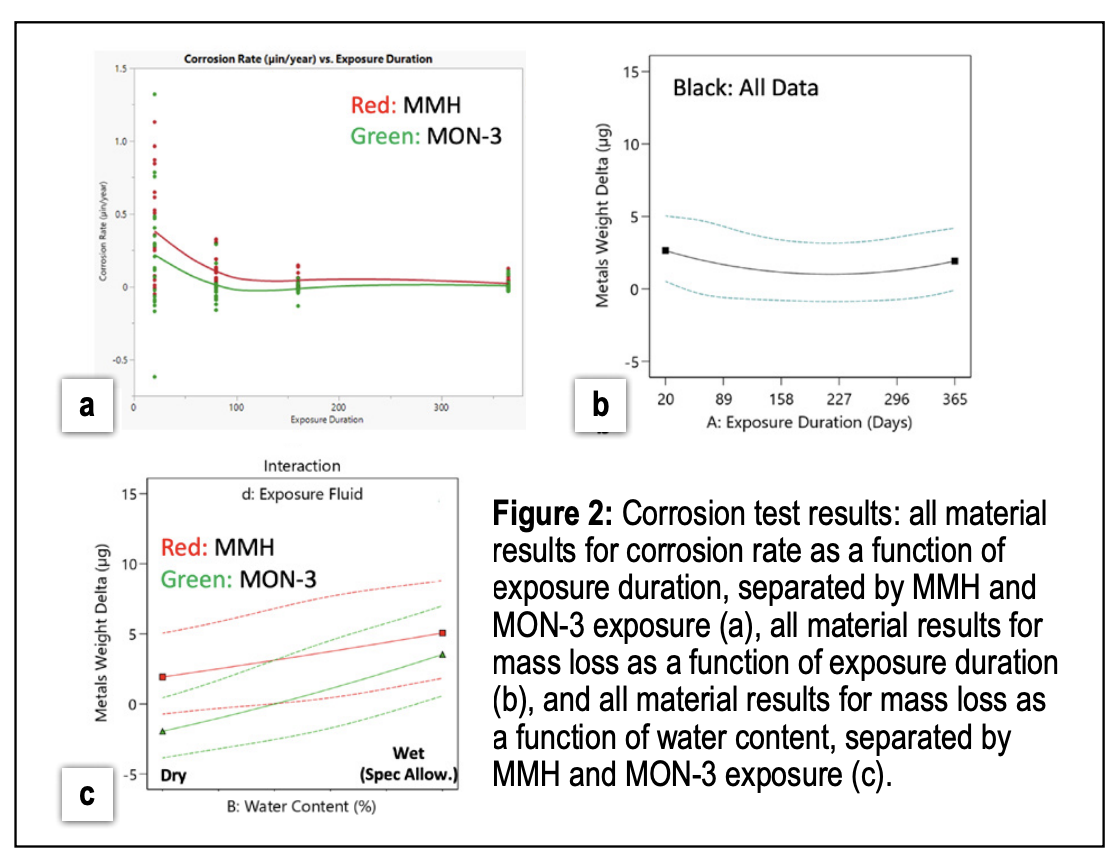This article is from the 2024 Technical Update.
The NESC evaluated material compatibility of some common aerospace metals in monomethylhydrazine (MMH) and nitrogen tetroxide (MON-3). Previous work had identified a lack of quantitative compatibility data for nickel alloy 718, 300 series stainless steel, and titanium Ti-6Al-4V in MMH and MON-3 to support the use of zero-failure-tolerant, thin-walled pressure barriers in these propellants. Static (i.e., not flowing) general corrosion and electrochemistry testing was conducted, evaluating varied processing forms and heat treatment of the metals, water content of propellant, and exposure duration. Corrosion-rate data for all tested product forms, fluids, and durations were on the order of 1 x 10–6 inch per year rather than the previously documented “less than 1 x 10–3 inch per year”. The majority of the corrosion products were seen in the first 20 days of exposure, with an overall corrosion rate decreasing with time due to the increased divisor (time). It is therefore recommended that corrosion testing be performed at multiple short-term durations to inform the need for longer-duration testing.
BackgroundNickel alloy 718, 300 series stainless steel, and Ti-6Al-4V are commonly used in storable propulsion systems (i.e., MMH/MON-3), but a concern was raised regarding what quantitative compatibility data were available for proposed zero-failure-tolerant, thin-walled (~0.005 to 0.010 inch thickness) pressure barrier designs. A literature search found that limited and conflicting data were available for commonly used aerospace metals in MMH and MON-3. For example, corrosion behavior was listed qualitatively (e.g., “A” rating), data on materials and fluids tested were imprecise, fluids were identified as contaminated without describing how they were contaminated, no compatibility data were found on relevant geometry specimens (i.e., very thin-walled or convoluted), and limited data were available to quantify differences between tested materials and flight components. When corrosion data were quantified, documented sensitivity was “1 x 10–3 inch per year or less”, which is insufficient for assessing long-duration, thin-walled, flight-weight applications.
DiscussionGeneral corrosion testing was performed with a static/non-flowing configuration based on NASA-STD-6001, Test 15 [1]. Design of experiments methods were used to develop a test matrix varying material, propellant, propellant water content, and tested duration. Materials tested were nickel alloy 718 (solution annealed sheet, aged sheet, aged/welded sheet, and hydroformed bellows), 300 series stainless steel (low carbon sheet, titanium stabilized sheet, and hydroformed bellows), and Ti 6Al-4V sheet. Samples were tested in sealed test tubes in MMH and MON-3 with water content ranging from as-received (“dry”) up to specification allowable limits [2,3]. Tested durations ranged from 20 to 365 days. Measurements included inductively coupled plasma mass spectrometry (ICPMS) to identify corrosion products and their concentrations in test fluid, gravimetric (i.e., scale) measurements pre- and post-exposure, and visual inspection. Bimetallic pairs (titanium stabilized 300 series stainless steel: Ti 6Al-4V and nickel alloy 718: Ti 6Al-4V) were tested for up to 65 days in both MMH and MON-3. The test setup incorporated important features of the test standard (e.g., electrode spacing and finish) and adapted the configuration for MMH/MON-3 operation. Measurements included potential difference and current flow between samples. Figure 1 shows images of the general corrosion and bimetallic pair test setups.
Test ResultsFor all tested materials and product forms, corrosion rates were on the order of 1 x 10–6 inch per year in MMH or MON-3, three orders of magnitude lower than historically reported. Corrosion products were generated in the first 20 days of exposure, and corrosion rate decreased with time due to the increase in divisor (i.e., time). Corrosion products increased as the water content of the propellants increased but remained in the same order of magnitude between the as-received dry propellant and propellant containing the maximum water content allowed by specification. Figure 2 illustrates test results for corrosion rate, mass loss with duration, and mass loss with water content. It is important to note that water has been demonstrated to contribute to flow decay even when water is within the specification allowable limit, and previous NASA-STD-6001 Test 15 data have demonstrated susceptibility of some nickel alloys to crevice-type corrosion attack [4]. Therefore, these results do not reduce the importance of considering the system impact of water content and evaluating for crevice corrosion behavior. Finally, in the bimetallic pair testing, tested materials did not measurably corrode in MON-3 and MMH within specification-allowable water content, as evidenced by no visual indications of corrosion and very low electrical interaction (i.e., corrosion rates derived to be less than 1 microinch per year from electrical interaction).
RecommendationsIt is recommended that corrosion testing be performed at multiple shortterm durations to inform the need for longer-duration testing.
References
- NASA-STD-6001 Flammability, Odor, Offgassing, and Compatibility Requirementsand Test Procedures for Materials In Environments that Support Combustion
- MIL-PRF-27404 Performance Specification: Propellant, Monomethylhydrazine
- MIL-PRF-26539 Performance Specification: Propellants, Dinitrogen Tetroxide
- WSTF Test 15 Report 12-45708 and WSTF Test 15 Report 13-46207

